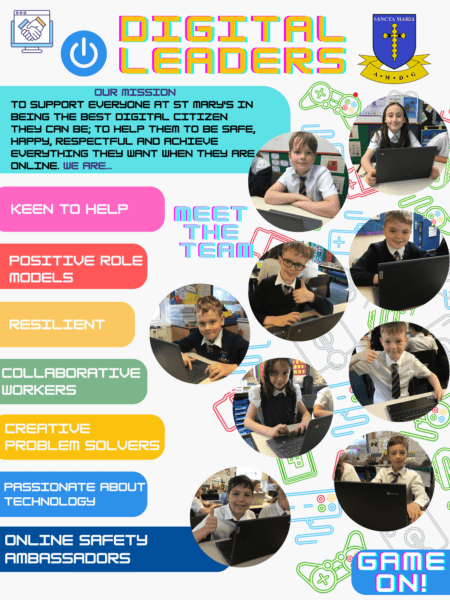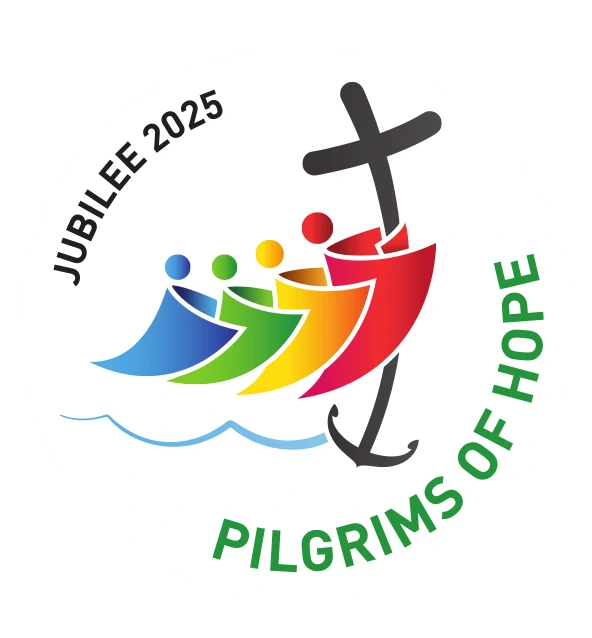Aims and Objectives
Our intent is to inspire in our pupils a love of the digital world, so that they can: access and evaluate this world competently, safely and responsibly; understand how it works and therefore adapt as it changes; and, most importantly, see its place and value in their future as confident, safe and successful digital citizens.
The curriculum produced (and regularly updated) by the National Centre for Computing Education (“NCCE”) provides the foundations of our St Mary’s Computing curriculum, allowing our pupils to benefit from national and dynamic expertise in the field. This solid basis affords us opportunity to add elements to our computing lessons, with the aim of nurturing the unique cultural capital of our children here in Marple Bridge, as well as allowing our children to thrive on the vast scope of enhancements that computing can make to the wider school curriculum – and life in general.
In terms of computing content, our curriculum is structured to ensure that our children have the skills required to meet the aims of the National Curriculum for computing, spanning digital literacy (including online safety), computer science and information technology. We aim to afford our children a broad, deep understanding of computing and how it links to their lives now, as well as what it might mean for their futures. Our curriculum offers a range of opportunities for consolidation, challenge and variety, meaning that our children are able to apply the fundamental principles and concepts of computer science. They develop analytical problem-solving skills learn to apply and evaluate the information technology available to them, with the aim of becoming responsible, competent, confident and creative users of it. We strive to empower our children with the digital literacy that will enable them to function as discerning digital citizens, capable of adapting their skills to and evaluating the constant changes in the world of computing.
The online safety element of the computing curriculum is delivered through lessons linked to the Education for a Connected World Framework. Additionally, the weekly delivery of year group specific Project Evolve objectives, linked to learning in either computing or PSHE, ensures rigour and progression in learning about online safety. Our school is subscribed to National Online Safety, through which pupil resources and staff CPD are accessed, as well as parental guidance, which is regularly communicated in our school bulletin. Online safety advice sessions are offered to parents in partnership with Stockport LA, the next scheduled meeting being on 28th November 2023. As a school, we mark Safer Internet Day annually with a week dedicated to online safety. In addition, our pupil team of Digital Leaders include online safety ambassadorship as part of their responsibility in school.
We recognise the importance and value of using computing skills to enhance the wider curriculum and opportunities for this are planned and mapped in each other subject for each year group.
Progression
Underpinned by the NCCE Curriculum, our computing curriculum provides an innovative progression framework where computing content (concepts, knowledge, skills, and objectives) has been organised into interconnected networks called learning graphs. An overview of this learning journey can be found here.
Although the technology strand of the Understanding of the World area of learning for EYFS is no longer statutory, computational thinking and learning about technology remain part of the EYFS curriculum at St Mary’s, mapped alongside Barefoot’s computational thinking and approaches for the Early Years: https://www.barefootcomputing.org/earlyyears
Transition to KS3 is supported by regular liaison with secondary colleagues through the CMAT-wide computing lead teams, as well as access for UKS2 teachers to resources and KS3 discussion via the NCCE and STEM discussion groups and boards.
Delivery of our computing curriculum
Timetabled Computing lessons are planned and delivered based upon the high-quality resources and Scheme of Work provided by the NCCE via Teach Computing. This scheme of work has been created (and is regularly updated) by subject experts, centred upon the latest pedagogical research at national level (and beyond) and teacher feedback from across the country. Within lessons, teachers strive to harness this international and national expertise in a form that is locally relevant to our pupils’ cultural capital, drawing on parent and visitor expertise, responding to areas of pupil interest and, moving forwards, seeking out local projects to inspire and engage pupils. In order to consolidate the skills and knowledge gleaned during computing lessons, teachers afford pupils with regular (specifically planned and ad hoc, pupil-led) opportunities for computing to enhance the wider curriculum.
Support with subject knowledge and delivery is provided to teachers in a number of ways, tailored to the individual, such as:
– Subject Leader support and input on a group and one-to-one basis;
– A wealth of CPD resources relevant to each topic available on the teachcomputing.org website;
– Access to local and national computing support and discussion groups via STEM and the NCCE;
– Access (upon request) to CPD courses tailored to the NCCE curriculum via STEM.
Bespoke support in relation to the development of our curriculum and the ways in which computing can be innovatively used to enhance the wider curriculum is provided by the Saint Ralph Sherwin CMAT Partner in IT Education and a centralised helpdesk team, as well as access to regular training sessions through the CMAT hub and constantly updated resources available (to both teachers and pupils) on our Pupil Homepage, supported by SpongyElephant.com.
Marking, Feedback and Assessment
This takes place digitally where possible, although opportunities are provided within the computing curriculum for ‘unplugged’ activities. Through the Pupil Homepage, pupils have a variety of means to access and record their opportunities. They are exposed to a variety of ways to store, save and submit their work, encompassing Office 365 Suite, as well as using web-based Apps, such as TinkerCAD, when required by a topic. Teachers can access and respond to these as the subject matter requires, for example through the setting of assignments on Teams or commenting on a piece of work saved in the class area on an App. Additionally, the NCCE curriculum provides for regular formative and summative assessment opportunities in lesson plans and end of unit checks.
The Learning Environment
We aim for our digital learning environment to be a safe, supportive and creative space, where children have opportunity to ask about and learn how to navigate the digital world that they encounter every day, both within and beyond the school gates. During computing lessons, our aim is for children to have access to their own device where possible. However, where devices need to be shared, we believe this affords children opportunities to consolidate and enhance their digital citizenship skills as they learn from and discuss technology with each other. When computing is used to enhance the wider curriculum, we encourage children to be resourceful in terms of their use of technology. As a school, we are exploring ways to display and celebrate our learning digitally, for example in class galleries on web-based Apps, through file sharing on Teams and on the school website. We are working towards a constant and dynamic digital presence in classrooms that celebrates our learning in computing, as opposed to paper-based display. Learning in computing is also celebrated through certificates and assembly time to showcase and share computing skills.
Digital Leaders
Our Year 5 Digital Leaders’ mission statement is: to support everyone at St Mary’s in being the best digital citizen they can be; to help them to be happy, respectful and achieve everything they want to when they are online.
Our current Digital Leaders team poster can be viewed below.
Extra-curricular computing activities
Code Club runs for KS2 pupils in Pentecost term and this Advent term will see the launch of our new Micro:bit club on Thursday evenings, following the exciting arrival of our BBC Micro:bits. In addition, computing enhances extra-curricular offerings such as online ‘book clubs’ via Teams, encouraging parents and children to share their thoughts on books enjoyed beyond our school reading scheme.
The role of the subject leader
The Subject Leader is responsible for:
· Leading the development and evaluation of our computing rationale, curriculum and resources
· Quality assuring computing knowledge webs, resources and planning throughout the school, as well as evaluating new resources which become available
· Monitoring the quality of teaching and learning of computing throughout the school, as well as the ways in which it used to enhance the wider curriculum
· Supporting colleagues with planning, teaching and assessing computing where required; ensuring they receive the training and resources required
· Monitoring pupils’ progress in computing and advising the Senior Leadership Team on action needed
· Liaising with the centralised Trust Team and Partner in ICT in terms of procurement of resources; as well as access to pooled resources
· Liaising with the SLT and subject leaders for PSHE and SEMH regarding the wider delivery of Online Safety teaching beyond the computing curriculum
· Keeping up-to-date with developments within the subject through research, CPD (including the Primary Computing Certificate), attendance of computing subject lead meetings and participation in online forums and working groups




